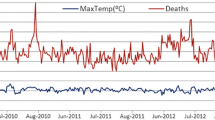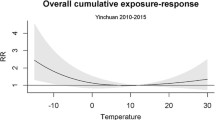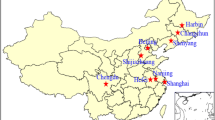Abstract
Few detailed, individual-focused studies have researched the added effect of temperature on cardiovascular disease (CVD), particularly in China. Moreover, no prior studies have explored the exposure-response relationship among all populations and different sub-sociodemographic groups. A distributed lag nonlinear model (DLNM) was applied to evaluate the adverse health effects of temperature on CVD mortality for all populations and different sub-sociodemographic groups (by age, sex, educational level, living arrangement, and occupation) in Beijing. Based on the exposure-response relationships, firstly, we proposed a new model (COCKTAIL, Code Of Climate Key To An Ill) for revealing the split-and-merge relationships of the temperature-CVD mortality curve. This method could be used to apply the CVD deaths in a studied area to forecast the exposure-response relationships in the same area in the future. Secondly, this is the most detailed study to analyze the relationship between temperature and CVD mortality for different subgroups among the existing researches for developed and developing countries. We found that the cold temperature (at − 14 °C) was the risk factor for people with low socioeconomic status, especially for single people (including unmarried, divorced, and widowed), for indoor workers, and for people with low education, compared with the minimum mortality temperature, with a cumulative increase of 3.9 (80%CI, 2.9–5.4), 3.8 (80%CI, 2.8–5.1), and 4.5 (80%CI, 3.1–6.3) times respectively. Meanwhile, the hot temperature (at 35 °C) was the risk factor for CVD death, with a cumulative increase of 2.6 (80%CI, 2.0–3.4) for females, and 3.1 (80%CI, 2.4–4.2) for single people. The varying CVD vulnerability in terms of CVD mortality among various groups may assist governments in preparing health resources and taking measures to prevent or reduce temperature-related deaths.



Similar content being viewed by others
References
Anderson G, Bell M (2011) Heat waves in the United States: mortality risk during heat waves and effect modification by heat wave characteristics in 43 US communities. Environ Health Perspect 119:210–218
Bai L, Ciredunzhu, Woodward A, Dawa, Xiraoruodeng, Liu QY (2014a) Temperature and mortality on the roof of the world: a time–series analysis in three Tibetan counties, China. Sci Total Environ 485–486:41–48
Bai L, Ding GQ, Gu SH, Bi P, Su BD, Qin DH (2014b) The effects of summer temperature and heat waves on heat–related illness in a coastal city of China, 2011–2013. Environ Res 132:212–219
Barreca AI (2012) Climate change, humidity, and mortality in the United States. J Environ Econ 63:19–34
Becker JA, Stewart LK (2011) Heat–related illness. Am Fam Physician 83:1325–1330
Bell ML, O’Neill MS, Ranjit N, Borja-Aburto VH, Cifuentes LA, Gouveia NC (2008) Vulnerability to heat–related mortality in Latin America: a case–crossover study in Sao Paulo, Brazil, Santiago, Chile and Mexico City, Mexico. Int J Epidemiol 37:796–804
Braga AL, Zanobetti A, Schwartz J (2002) The effect of weather on respiratory and cardiovascular deaths in 12 United States cities. Environ Health Perspect 110:859–863
Chen K, Bi J, Chen J, Chen XD, Huang L, Zhou L (2015) Influence of heat wave definitions to the added effect of heat waves on daily mortality in Nanjing, China. Sci Total Environ 507:18–25
Chen K, Zhou L, Chen XD, Ma ZW, Liu Y, Huang L et al (2016) Urbanization level and vulnerability to heat–related mortality in Jiangsu province, China. Environ Health Perspect 124(12):1863–1869
China Meteorological Data Sharing Service System (CMDS) (2017) Available: http://cdc.nmic.cn/home.do [Accessed on 5 August 2014]
D’Ippoliti D, Michelozzi P, Marino C, de’Donato F, Menne B, Katsouyanni K et al (2010) The impact of heat waves on mortality in 9 European cities: results from the Euro HEAT project. Environ Health 9:358–366
Feng X, Li ZL, Gao Y (2005) Effects of income, marriage and family on life satisfaction of elderly people. China Public Health 21:142–147
Gasparrini A (2011) Distributed lag linear and non-linear models in R: the package dlnm. J Stat Softw 43(8):1–20
Goggins WB, Chan EYY, Ng E, Ren C, Chen L (2012) Effect modification of the association between short–term meteorological factors and mortality by urban heat islands in Hong Kong. PLoS One 7:e38551
Hajat S, Kosatky T (2010) Heat–related mortality: a review and exploration of heterogeneity. J Epidemiol Community Health 64(9):753–760
Keatinge WR, Coleshaw SR, Easton JC, Cotter F, Mattock MB, Chelliah R (1986) Increased platelet and red cell counts, blood viscosity, and plasma cholesterol levels during heat stress, and mortality from coronary and cerebral thrombosis. Am J Med 81:795–800
Ma W, Chen R, Kan H (2014) Temperature–related mortality in 17 large Chinese cities: how heat and cold affect mortality in China. Environ Res 134:127–133
Ma WJ, Zeng WL, Zhou MG, Wang LJ, Rutherford S, Lin HL et al (2015) The short–term effect of heat waves on mortality and its modifiers in China: an analysis from 66 communities. Environ Int 75:103–109
Miranda JJ, Gilman RH, Smeeth L (2011) Differences in cardiovascular risk factors in rural, urban and rural–to–urban migrants in Peru. Heart 97(10):787–796
Nawrot TS, Staessen JA, Fagard RH, Van Bortel LM, Struijker-Boudier HA (2005) Endothelial function and outdoor temperature. Eur J Epidemiol 20:407–410
O’Neill MS, Zanobetti A, Schwartz J (2003) Modifiers of the temperature and mortality association in seven US cities. Am J Epidemiol 157(12):1074–1082
Peng RD, Dominici F, Louis TA (2006) Model choice in time series studies of air pollution and mortality. J R Stat Soc 169:179–203
Phung D, Guo YM, Thai P, Rutherford S, Wang XM, Nguyen M et al (2016) The effects of high temperature on cardiovascular admissions in the most populous tropical city in Vietnam. Environ Pollut 208:33–39
Qiao Z, Guo YM, Yu W, Tong SL (2015) Assessment of short– and long–term mortality displacement in heat–related deaths in Brisbane, Australia, 1996–2004. Environ Health Perspect 123(8):766–772
Smith JE (2005) Cooling methods used in the treatment of exertional heat illness. Br J Sports Med 39:503–507
Son JY, Gouveia N, Bravo MA, Freitas CU, Bell ML (2016) The impact of temperature on mortality in a subtropical city: effects of cold, heat, and heat waves in São Paulo, Brazil. Int J Biometeorol 60(1):113–121
Stafoggia M, Forastiere F, Agostini D, Biggeri A, Bisanti L, Cadum E, Caranci N, de??Donato F, de Lisio S, de Maria M, Michelozzi P, Miglio R, Pandolfi P, Picciotto S, Rognoni M, Russo A, Scarnato C, Perucci CA (2006) Vulnerability to heat–related mortality: a multicity, population–based, case–crossover analysis. Epidemiology 17:315–323
Tan J, Zheng Y, Tang X, Guo C (2009) The urban heat island and its impact on heat waves and human health in Shanghai. Int J Biometeorol 54:75–84
Tord K (2009) Climate change, direct heat exposure, health and well–being in low and middle–income countries. Glob Health Action 2:920–928
Tsangari H, Paschalidou A, Vardoulakis S, Heaviside C, Konsoula Z, Christou S et al (2015) Human mortality in Cyprus: the role of temperature and particulate air pollution. Reg Environ Chang. https://doi.org/10.1007/s10113-015-0793-2
Urban A, Davídkovová H, Kyselý J (2014) Heat– and cold–stress effects on cardiovascular mortality and morbidity among urban and rural populations in the Czech Republic. Int J Biometeorol 58(6):1057–1068
Wang MZ, Zheng S, He SL, Li B, Teng HJ, Wang SG et al (2013) The association between diurnal temperature range and emergency room admissions for cardiovascular, respiratory, digestive and genitourinary disease among the elderly: a time series study. Sci. Total Environ 456–457:370–375
Wang CC, Chen RJ, Kuang XY, Duan XL, Kan HD (2014) Temperature and daily mortality in Suzhou, China: a time series analysis. Sci Total Environ 466–467:985–990
Wang XY, Li GX, Liu LQ, Westerdahl D, Jin XB, Pan XC (2015) Effects of extreme temperatures on cause–specific cardiovascular mortality in China. Int J Environ Res Public Health 12(12):16136–16156
Yang CY, Meng X, Chen RJ, Cai J, Zhao ZH, Wan Y (2015a) Long–term variations in the association between ambient temperature and daily cardiovascular mortality in Shanghai, China. Sci Total Environ 538:524–530
Yang J, Ou CQ, Guo YM, Li L, Guo C, Chen PY (2015b) The burden of ambient temperature on years of life lost in Guangzhou, China. Sci Rep 5(12250):1–9
Yang J, Yin P, Zhou MG, Ou CQ, Guo YM, Gasparrini A et al (2015c) Cardiovascular mortality risk attributable to ambient temperature in China. Heart 101:1–7
Yang XF, Li LF, Wang JF, Huang JX, Lu SJ (2015d) Cardiovascular mortality associated with low and high temperatures: determinants of inter–region vulnerability in China. Int J Environ Res Public Health 12(6):5918–5933
Zeng WL, Lao XQ, Rutherford S, Xu YJ, Xu XJ, Lin HL et al (2014) The effect of heat waves on mortality and effect modifiers in four communities of Guangdong Province, China. Sci Total Environ 482–483:214–221
Funding
This work was supported by the National Natural Science Foundation of China (grant nos. 41531179 and 41421001) and the Ministry of Science and Technology of China (grant no. 2014FY121100). The funders played no role in determining the study design, data collection, or analysis methods employed; in our decision to publish; or in preparing the manuscript.
Author information
Authors and Affiliations
Corresponding author
Ethics declarations
Competing interests
The authors declare that they have no conflict of interest.
Additional information
Responsible editor: Philippe Garrigues
Publisher’s note
Springer Nature remains neutral with regard to jurisdictional claims in published maps and institutional affiliations.
Electronic supplementary material
Table S1
(DOCX 21 kb)
Supplementary Fig. S1
The exposure-response relationships between daily mean temperature and CVD cumulative relative mortality risk for different subgroups: (a) by sex; (b) by age; (c) by educational level; (d) by living arrangement and (e) by occupation. (DOCX 132 kb)
Rights and permissions
About this article
Cite this article
Yin, Q., Wang, J., Su, J. et al. A new method to estimate the temperature-CVD mortality relationship. Environ Sci Pollut Res 26, 8895–8901 (2019). https://doi.org/10.1007/s11356-019-04247-6
Received:
Accepted:
Published:
Issue Date:
DOI: https://doi.org/10.1007/s11356-019-04247-6




